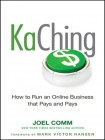KaChing: How to Run an Online Business that Pays and Pays Comm, Joel (books for 8th graders txt) 📖

Book online «KaChing: How to Run an Online Business that Pays and Pays Comm, Joel (books for 8th graders txt) 📖». Author Comm, Joel
You’ll want to do whatever you can to keep that community together. That group of people with an interest in bonsai trees, photography, home repairs, or whatever your site is about should see you as one of its leaders. It should regard your site as a prime source for information about its topic.
When that happens, you draw lots of easy traffic to your web site. You are talked about constantly. The price of advertising on your site shoots through the roof, and you find it very easy to grow and sell.
In the past, turning your readers into a community used to be fairly difficult. You could look at your site statistics and see all sorts of information about your users. You could see where they were located, what search term they entered into a search engine before they reached you, which site they reached you from, and even which kind of browser they used to view your site.
But you didn’t really get to see them. Users were numbers in a table, faceless figures who determined your month’s online revenues. That’s all changed.
Now, users are people. You can see their names in their comments. You can read about their lives on Twitter, you can become friends on Facebook, and you can form professional relationships on Linkedln.
Those are all important elements in a successful site. Users have such a huge choice of Web pages to read and sites to visit that you have to keep them entertained, interested, and engaged if you’re going to ensure that your site grows. You want your visitors to see you not as another source to check every now and then, but as a friend they have online. Reading your web site should be as much a part of their daily routine as checking e-mail and visiting their Facebook page.
First, encourage people to leave comments on your blog. You should find that readers do that anyway, and it’s a fantastic thing. Seeing the results of a KaChing in your stats table is always encouraging, but when you get unsolicited comments from readers saying, “Great post!” and “Fascinating article,” you really do feel you’re on the right track.
Those sorts of comments are nice ego boosters, but you want more than that. You want users to leave their opinions and continue the discussion you’ve started. If you’ve written a post explaining how to create good compost, you want other gardeners to chime in with their composting tips. If your post is an opinion piece about the noise electric hedge trimmers make, then you want other people to join the argument, whether they agree with you or not.
Most of all, you want comments on your blog submitted by professionals. That shows that your blog has influence, is respected, and has content that can’t be found anywhere else—even if you didn’t write that content yourself.
There are things you can do to encourage comments. Writing about controversial subjects is perhaps the easiest. Every niche has issues about which people feel strongly. Editors on news sites know that when they write a news story about abortion, Israel, or health care, they’re going to get page after page of comments. If they write about the cost of potato chips in Sweden, however, it’s unlikely that they’ll get any.
You shouldn’t be writing about controversial topics all the time. That would make your site look predictable. But you should know which subjects are most likely to cause a storm in your community.
You should know too the effect that storm is going to have on you. My blog, JoelComm.com, is mostly about entrepreneurship and online marketing. Occasionally though, I’ll let fly on a subject that I feel strongly about it. It could be politics, business, or people not washing their hands after going to the bathroom. Those posts always generate lots of extra comments, but they can also irritate people—especially people with dirty hands (and they know who they are). Writing about controversial topics might cost you a few users who strongly disagree with you, but overall it’s a winner. Those who remain feel a closer connection with you. You’re not just a web site, you’re a person with opinions, thoughts, and feelings. You’re someone just like your readers: a friend and a member of their community.
Comments are one way for your readers to communicate with you and to share their thoughts with other members of your community. It’s social media, though, that’s really made the difference for publishers trying to turn their users into a community.
The three most important sites for an Internet publisher are Facebook, Twitter, and LinkedIn. Each site has its strengths and each serves a different purpose.
You’re probably already using Facebook to keep in touch with old friends and colleagues. Once you launch a web site, it’s worth creating a Facebook fan page for your site, which acts just like your regular Facebook page. You’ll be able to use status updates to tell people when you’ve published a new post. You’ll also be able to create discussions on topics that are important to your community. Most of all, you’ll be able to see who is reading your posts, and they’ll be able to see you. That helps to create a much more powerful connection between you and your readers and between your readers themselves.
LinkedIn is similar, but it has a greater emphasis on business relationships. You should certainly create a profile for





Comments (0)